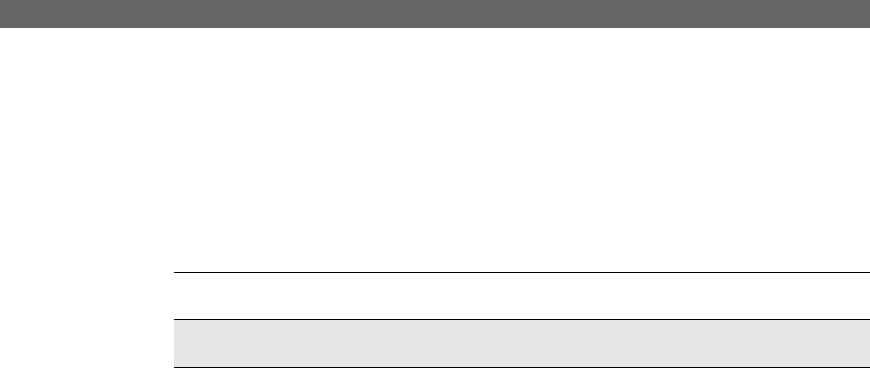Wooldridge - Introductory Econometrics - A Modern Approach, 2e
Подождите немного. Документ загружается.


educ*, and so the measurement error is negative. At a minimum, e
1
cannot have zero
mean, and e
1
and educ* are probably correlated.
QUESTION 9.4
An incumbent’s decision not to run may be systematically related to how he or she
expects to do in the election. Therefore, we may only have a sample of incumbents who
are stronger, on average, than all possible incumbents who could run. This results in a
sample selection problem if the population of interest includes all incumbents. If we are
only interested in the effects of campaign expenditures on election outcomes for incum-
bents who seek reelection, there is no sample selection problem.
CHAPTER 10
QUESTION 10.1
The impact propensity is .48, while the long-run propensity is .48 .15 .32 .65.
QUESTION 10.2
The explanatory variables are x
t1
z
t
and x
t2
z
t1
. The absence of perfect collinear-
ity means that these cannot be constant, and there cannot be an exact linear relationship
between them in the sample. This rules out the possibility that all the z
1
,…,z
n
take on
the same value or that the z
0
, z
1
,…,z
n1
take on the same value. But it eliminates other
patterns as well. For example, if z
t
a bt for constants a and b, then z
t1
a
b(t 1) (a bt) b z
t
b, which is a perfect linear function of z
t
.
QUESTION 10.3
If {z
t
} is slowly moving over time—as is the case for the levels or logs of many eco-
nomic time series—then z
t
and z
t1
can be highly correlated. For example, the correla-
tion between unem
t
and unem
t1
in PHILLIPS.RAW is .74.
QUESTION 10.4
No, because a linear time trend with
1
0 becomes more and more negative as t gets
large. Since gfr cannot be negative, a linear time trend with a negative trend coefficient
cannot represent gfr in all future time periods.
QUESTION 10.5
The intercept for March is
0
2
. Seasonal dummy variables are strictly exogenous
because they follow a deterministic pattern. For example, the months do not change
based upon whether either the explanatory variables or the dependent variable change.
CHAPTER 11
QUESTION 11.1
(i) No, because E(y
t
)
0
1
t depends on t. (ii) Yes, because y
t
E(y
t
) e
t
is an
i.i.d. sequence.
Appendix F Answers to Chapter Questions
770
xd 7/14/99 9:34 PM Page 770

QUESTION 11.2
We plug inf
t
e
(1/2)inf
t1
(1/2)inf
t2
into inf
t
inf
t
e
1
(unem
t
0
) e
t
and
rearrange: inf
t
(1/2)(inf
t1
inf
t2
)
0
1
unem
t
e
t
, where
0
1
0
,as
before. Therefore, we would regress y
t
on unem
t
, where y
t
inf
t
(1/2)(inf
t1
inf
t2
). Note that we lose the first two observations in constructing y
t
.
QUESTION 11.3
No, because u
t
and u
t1
are correlated. In particular, Cov(u
t
,u
t1
) E[(e
t
1
e
t1
)(e
t1
1
e
t2
)]
1
E(e
t
2
1
)
1
e
2
0 if
1
0. If the errors are serially
correlated, the model cannot be dynamically complete.
CHAPTER 12
QUESTION 12.1
We use equation (12.4). Now, only adjacent terms are correlated. In particular, the
covariance between x
t
u
t
and x
t1
u
t1
is x
t
x
t1
Cov(u
t
,u
t1
) x
t
x
t1
e
2
. Therefore, the
formula is
Var(
ˆ
1
) SST
x
2
冸
兺
n
t1
x
t
2
Var(u
t
) 2
兺
n1
t1
x
t
x
t1
E(u
t
u
t1
)
冹
2
/SST
x
(2/SST
x
2
)
兺
n1
t1
e
2
x
t
x
t1
2
/SST
x
e
2
(2/SST
x
2
)
兺
n1
t1
x
t
x
t1
where
2
Var(u
t
)
e
2
1
2
e
2
e
2
(1
1
2
). Unless x
t
and x
t1
are uncorrelated in
the sample, the second term is nonzero whenever
0. Notice that if x
t
and x
t1
are
positively correlated and
0, the true variance is actually smaller than the usual vari-
ance. When the equation is in levels (as opposed to being differenced), the typical case
is
0, with positive correlation between x
t
and x
t1
.
QUESTION 12.2
ˆ
1.96se(
ˆ
), where se(
ˆ
) is the standard error reported in the regression. Or, we could
use the heteroskedasticity-robust standard error. Showing that this is asymptotically
valid is complicated because the OLS residuals depend on
ˆ
j
, but it can be done.
QUESTION 12.3
The model we have in mind is u
t
1
u
t1
4
u
t4
e
t
, and we want to test H
0
:
1
0,
4
0 against the alternative that H
0
is false. We would run the regression of u
ˆ
t
on
u
ˆ
t1
and u
ˆ
t4
to obtain the usual F statistic for joint significance of the two lags. (We
are testing two restrictions.)
QUESTION 12.4
We would probably estimate the equation using first differences, as
ˆ
.92 is close
enough to one to raise questions about the levels regression. See Chapter 18 for more
discussion.
Appendix F Answers to Chapter Questions
771
xd 7/14/99 9:34 PM Page 771

QUESTION 12.5
Because there is only one explanatory variable, the White test is easy to compute.
Simply regress u
ˆ
t
2
on return
t1
and return
t
2
1
(with an intercept, as always) and com-
pute the F test for joint significance of return
t1
and return
t
2
1
. If these are jointly sig-
nificant at a small enough significance level, we reject the null of homoskedasticity.
CHAPTER 13
QUESTION 13.1
Yes, assuming that we have controlled for all relevant factors. The coefficient on black
is 1.076, and, with a standard error of .174, it is not statistically different from one. The
95% confidence interval is from about .735 to 1.417.
QUESTION 13.2
The coefficient on highearn shows that, in the absence of any change in the earnings
cap, high earners spend much more time—on the order of 29.2% on average [because
exp(.256) 1 ⬇ .292]—on workers’ compensation.
QUESTION 13.3
First, E(v
i1
) E(a
i
u
i1
) E(a
i
) E(v
i1
) 0. Similarly, E(v
i2
) 0. Therefore, the
covariance between v
i1
and v
i2
is simply E(v
i1
v
i2
) E[(a
i
u
i1
)(a
i
u
i2
)] E(a
i
2
)
E(a
i
u
i1
) E(a
i
u
i2
) E(u
i1
u
i2
) E(a
i
2
), because all of the covariance terms are zero by
assumption. But E(a
i
2
) Var(a
i
), because E(a
i
) 0. This causes positive serial corre-
lation across time in the errors within each i, which biases the usual OLS standard
errors in a pooled cross-sectional regression.
QUESTION 13.4
Because admn admn
90
admn
85
is the difference in binary indicators, it can be 1
if and only if admn
90
0 and admn
85
1. In other words, Washington state had an
administrative per se law in 1985 but it was repealed by 1990.
QUESTION 13.5
No, just as it does not cause bias and inconsistency in a time series regression with
strictly exogenous explanatory variables. There are two reasons it is a concern. First,
serial correlation in the errors in any equation generally biases the usual OLS standard
errors and test statistics. Second, it means that pooled OLS is not as efficient as esti-
mators that account for the serial correlation (as in Chapter 12).
CHAPTER 14
QUESTION 14.1
Whether we use first differencing or the within transformation, we will have trouble
estimating the coefficient on kids
it
. For example, using the within transformation, if
kids
it
does not vary for family i, then ki
¨
ds
it
kids
it
苶
kids
i
0 for t 1,2,3. As long
as some families have variation in kids
it
, then we can compute the fixed effects estima-
Appendix F Answers to Chapter Questions
772
xd 7/14/99 9:34 PM Page 772

tor, but the kids coefficient could be very imprecisely estimated. This is a form of mul-
ticollinearity in fixed effects estimation (or first-differencing estimation).
QUESTION 14.2
If a firm did not receive a grant in the first year, it may or may not receive a grant in
the second year. But if a firm did receive a grant in the first year, it could not get a grant
in the second year. That is, if grant
1
1, then grant 0. This induces a negative cor-
relation between grant and grant
1
. We can verify this by computing a regression of
grant on grant
1
, using the data in JTRAIN.RAW for 1989. Using all firms in the sam-
ple, we get
gra
ˆ
nt (.248) (.248) grant
1
.
gra
ˆ
nt (.035) (.072) grant
1
.
n 157, R
2
.070.
The coefficient on grant
1
must be the negative of the intercept, because gra
ˆ
nt 0
when grant
1
1.
QUESTION 14.3
It suggests that the unobserved effect a
i
is positively correlated with union
it
. Remember,
pooled OLS leaves a
i
in the error term, while fixed effects removes a
i
. By definition, a
i
has a positive effect on log(wage). By the standard omitted variables analysis (see
Chapter 3), OLS has an upward bias when the explanatory variable (union) is positively
correlated with the omitted variable (a
i
). Thus, belonging to a union appears to be pos-
itively related to time-constant, unobserved factors that affect wage.
QUESTION 14.4
Not if all sisters within a family have the same mother and father. Then, because the
parents’ race variables would not change by sister, they would be differenced away in
(14.13).
CHAPTER 15
QUESTION 15.1
Probably not. In the simple equation (15.18), years of education is part of the error term.
If some men who were assigned low draft lottery numbers obtained additional school-
ing, then lottery number and education are negatively correlated, which violates the first
requirement for an instrumental variable in equation (15.4).
QUESTION 15.2
(i) For (15.27), we require that high school peer group effects carry over to college.
Namely, for a given SAT score, a student who went to a high school where smoking
marijuana was more popular would smoke more marijuana in college. Even if the iden-
tification condition (15.27) holds, the link might be weak.
(ii) We have to assume that percent of students using marijuana at a student’s high
school is not correlated with unobserved factors that affect college grade point average.
Appendix F Answers to Chapter Questions
773
xd 7/14/99 9:34 PM Page 773

While we are somewhat controlling for high school quality by including SAT in the
equation, this might not be enough. Perhaps high schools that did a better job of prepar-
ing students for college also had fewer students smoking marijuana. Or, marijuana
usage could be correlated with average income levels. These are, of course, empirical
questions that we may or may not be able to answer.
QUESTION 15.3
While prevalence of the NRA and subscribers to gun magazines are probably correlated
with the presence of gun control legislation, it is not obvious that they are uncorrelated
with unobserved factors that affect the violent crime rate. In fact, we might argue that
a population interested in guns is a reflection of high crime rates, and controlling for
economic and demographic variables is not sufficient to capture this. It would be hard
to argue persuasively that these are truly exogenous in the violent crime equation.
QUESTION 15.4
As usual, there are two requirements. First, it should be the case that growth in govern-
ment spending is systematically related to the party of the president, after netting out
the investment rate and growth in the labor force. In other words, the instrument must
be partially correlated with the endogenous explanatory variable. While we might think
that government spending grows more slowly under Republican presidents, this cer-
tainly has not always been true in the United States and would have to be tested using
the t statistic on REP
t1
in the reduced form gGOV
t
0
1
REP
t1
2
INVRAT
t
3
gLAB
t
v
t
. We must assume that the party of the president has no separate effect on
gGDP. This would be violated if, for example, monetary policy differs systematically
by presidential party and has a separate effect on GDP growth.
CHAPTER 16
QUESTION 16.1
Probably not. It is because firms choose price and advertising expenditures jointly that
we are not interested in the experiment where, say, advertising changes exogenously
and we want to know the effect on price. Instead, we would model price and advertis-
ing each as a function of demand and cost variables. This is what falls out of the eco-
nomic theory.
QUESTION 16.2
We must assume two things. First, money supply growth should appear in equation
(16.22), so that it is partially correlated with inf. Second, we must assume that money
supply growth does not appear in equation (16.23). If we think we must include money
supply growth in equation (16.23), then we are still short an instrument for inf. Of
course, the assumption that money supply growth is exogenous can also be questioned.
QUESTION 16.3
Use the Hausman test from Chapter 15. In particular, let v
ˆ
2
be the OLS residuals from
the reduced form regression of open on log(pcinc) and log(land). Then, use an OLS
Appendix F Answers to Chapter Questions
774
xd 7/14/99 9:34 PM Page 774

regression of inf on open, log(pcinc), and v
ˆ
2
and compute the t statistic for significance
of v
ˆ
2
. If v
ˆ
2
is significant, the 2SLS and OLS estimates are statistically different.
QUESTION 16.4
The demand equation looks like
log( fish
t
)
0
1
log(prcfish
t
)
2
log(inc
t
)
3
log(prcchick
t
)
4
log(prcbeef
t
) u
t1
,
where logarithms are used so that all elasticities are constant. By assumption, the
demand function contains no seasonality, so the equation does not contain monthly
dummy variables (say feb
t
, mar
t
,…,dec
t
, with January as the base month). Also, by
assumption, the supply of fish is seasonal, which means that the supply function does
depend on at least some of the monthly dummy variables. Even without solving the
reduced form for log(prcfish), we conclude that it depends on the monthly dummy vari-
ables. Since these are exogenous, they can be used as instruments for log(prcfish) in the
demand equation. Therefore, we can estimate the demand-for-fish equation using
monthly dummies as the IVs for log(prcfish). Identification requires that at least one
monthly dummy variable appears with a nonzero coefficient in the reduced form for
log(prcfish).
CHAPTER 17
QUESTION 17.1
H
0
:
4
5
6
0, so that there are three restrictions and therefore three df in the
LR or Wald test.
QUESTION 17.2
We need the partial derivative of (
ˆ
0
ˆ
1
nwifeinc
ˆ
2
educ
ˆ
3
exper
ˆ
4
exper
2
…) with respect to exper, which is
()(
ˆ
3
2
ˆ
4
exper), where
() is evaluated at
the given values and the initial level of experience. Therefore, we need to evaluate the
standard normal probability density at .270 .012(20.13) .131(12.3) .123(10)
.0019(10
2
) .053(42.5) .868(0) .036(1) ⬇ .463, where we plug in the initial level
of experience (10). But
(.463) (2
)
1/2
exp[(.463
2
)/2] ⬇ .358. Next, we multiply
this by
ˆ
3
2
ˆ
4
exper, which is evaluated at exper 10. The partial effect using the
calculus approximation is .358[.123 2(.0019)(10)] ⬇ .030. In other words, at the
given values of the explanatory variables and starting at exper 10, the next year of
experience increases the probability of labor force participation by about .03.
QUESTION 17.3
No. The number of extramarital affairs is a nonnegative integer, which presumably
takes on zero or small numbers for a substantial fraction of the population. It is not real-
istic to use a Tobit model, which, while allowing a pileup at zero, treats y as being con-
tinuously distributed over positive values. Formally, assuming that y max(0,y*),
where y* is normally distributed, is at odds with the discreteness of the number of extra-
marital affairs when y 0.
Appendix F Answers to Chapter Questions
775
xd 7/14/99 9:34 PM Page 775

QUESTION 17.4
The adjusted standard errors are the usual Poisson MLE standard errors multiplied by
ˆ
兹
苶
2 ⬇ 1.41, so the adjusted standard errors will be about 41% higher. The quasi-
LR statistic is the usual LR statistic divided by
ˆ
2
, so it will be one-half of the usual LR
statistic.
QUESTION 17.5
By assumption, mvp
i
0
x
i

u
i
, where, as usual, x
i

denotes a linear function
of the exogenous variables. Now, observed wage is the largest of the minimum wage
and the marginal value product, so wage
i
max(minwage
i
,mvp
i
), which is very similar
to equation (17.34), except that the max operator has replaced the min operator.
CHAPTER 18
QUESTION 18.1
We can plug these values directly into equation (18.1) and take expectations. First,
because z
s
0, for all s 0, y
1
u
1
. Then, z
0
1, so y
0
0
u
0
.
For h 1, y
h
h1
h
u
h
. Because the errors have zero expected values,
E(y
1
)
,E(y
0
)
0
, and E(y
h
)
h1
h
, for all h 1. As h * ,
h
* 0. It follows that E(y
h
) *
as h * , that is, the expected value of y
h
returns to
the expected value before the increase in z, at time zero. This makes sense: while the
increase in z lasted for two periods, it is still a temporary increase.
QUESTION 18.2
Under the described setup, y
t
and x
t
are i.i.d. sequences that are independent of one
another. In particular, y
t
and x
t
are uncorrelated. If
ˆ
1
is the slope coefficient from
regressing y
t
on x
t
, t 1,2, …, n, then plim
ˆ
1
0. This is as it should be, as we are
regressing one I(0) process on another I(0) process, and they are uncorrelated. We write
the equation y
t
0
1
x
t
e
t
, where
0
1
0. Because {e
t
} is independent
of {x
t
}, the strict exogeneity assumption holds. Moreover, {e
t
} is serially uncorrelated
and homoskedastic. By Theorem 11.2 in Chapter 11, the t statistic for
ˆ
1
has an approx-
imate standard normal distribution. If e
t
is normally distributed, the classical linear
model assumptions hold, and the t statistic has an exact t distribution.
QUESTION 18.3
Write x
t
x
t1
a
t
, where {a
t
} is I(0). By assumption, there is a linear combination,
say s
t
y
t
x
t
, which is I(0). Now, y
t
x
t1
y
t
(x
t
a
t
) s
t
a
t
. Because
s
t
and a
t
are I(0) by assumption, so is s
t
a
t
.
QUESTION 18.4
Just use the sum of squared residuals form of the F test and assume homoskedasticity.
The restricted SSR is obtained by regressing hy6
t
hy3
t1
(hy6
t1
hy3
t2
) on
a constant. Notice that
0
is the only parameter to estimate in hy6
t
0
0
hy3
t1
(hy6
t1
hy3
t2
) when the restrictions are imposed. The unrestricted sum of
squared residuals is obtained from equation (18.39).
Appendix F Answers to Chapter Questions
776
xd 7/14/99 9:34 PM Page 776

QUESTION 18.5
We are fitting two equations: y
ˆ
t
ˆ
ˆ
t and y
ˆ
t
ˆ
ˆ
year
t
. We can obtain the rela-
tionship between the parameters by noting that year
t
t 49. Plugging this into the
second equation gives y
ˆ
t
ˆ
ˆ
(t 49) (
ˆ
49
ˆ
)
ˆ
t. Matching the slope and
intercept with the first equation gives
ˆ
ˆ
—so that the slopes on t and year
t
are iden-
tical—and
ˆ
ˆ
49
ˆ
. Generally, when we use year rather than t, the intercept will
change, but the slope will not. (You can verify this by using one of the time series data
sets, such as HSEINV.RAW or INVEN.RAW.) Whether we use t or some measure of
year does not change fitted values, and, naturally, it does not change forecasts of future
values. The intercept simply adjusts appropriately to different ways of including a trend
in the regression.
Appendix F Answers to Chapter Questions
777
xd 7/14/99 9:34 PM Page 777

778
Appendix G
Statistical Tables
TABLE G.1
Cumulative Areas Under the Standard Normal Distribution
z 0123456789
⫺3.0 0.0013 0.0013 0.0013 0.0012 0.0012 0.0011 0.0011 0.0011 0.0010 0.0010
⫺2.9 0.0019 0.0018 0.0018 0.0017 0.0016 0.0016 0.0015 0.0015 0.0014 0.0014
⫺2.8 0.0026 0.0025 0.0024 0.0023 0.0023 0.0022 0.0021 0.0021 0.0020 0.0019
⫺2.7 0.0035 0.0034 0.0033 0.0032 0.0031 0.0030 0.0029 0.0028 0.0027 0.0026
⫺2.6 0.0047 0.0045 0.0044 0.0043 0.0041 0.0040 0.0039 0.0038 0.0037 0.0036
⫺2.5 0.0062 0.0060 0.0059 0.0057 0.0055 0.0054 0.0052 0.0051 0.0049 0.0048
⫺2.4 0.0082 0.0080 0.0078 0.0075 0.0073 0.0071 0.0069 0.0068 0.0066 0.0064
⫺2.3 0.0107 0.0104 0.0102 0.0099 0.0096 0.0094 0.0091 0.0089 0.0087 0.0084
⫺2.2 0.0139 0.0136 0.0132 0.0129 0.0125 0.0122 0.0119 0.0116 0.0113 0.0110
⫺2.1 0.0179 0.0174 0.0170 0.0166 0.0162 0.0158 0.0154 0.0150 0.0146 0.0143
⫺2.0 0.0228 0.0222 0.0217 0.0212 0.0207 0.0202 0.0197 0.0192 0.0188 0.0183
⫺1.9 0.0287 0.0281 0.0274 0.0268 0.0262 0.0256 0.0250 0.0244 0.0239 0.0233
⫺1.8 0.0359 0.0351 0.0344 0.0336 0.0329 0.0322 0.0314 0.0307 0.0301 0.0294
⫺1.7 0.0446 0.0436 0.0427 0.0418 0.0409 0.0401 0.0392 0.0384 0.0375 0.0367
⫺1.6 0.0548 0.0537 0.0526 0.0516 0.0505 0.0495 0.0485 0.0475 0.0465 0.0455
⫺1.5 0.0668 0.0655 0.0643 0.0630 0.0618 0.0606 0.0594 0.0582 0.0571 0.0559
⫺1.4 0.0808 0.0793 0.0778 0.0764 0.0749 0.0735 0.0721 0.0708 0.0694 0.0681
⫺1.3 0.0968 0.0951 0.0934 0.0918 0.0901 0.0885 0.0869 0.0853 0.0838 0.0823
⫺1.2 0.1151 0.1131 0.1112 0.1093 0.1075 0.1056 0.1038 0.1020 0.1003 0.0985
⫺1.1 0.1357 0.1335 0.1314 0.1292 0.1271 0.1251 0.1230 0.1210 0.1190 0.1170
⫺1.0 0.1587 0.1562 0.1539 0.1515 0.1492 0.1469 0.1446 0.1423 0.1401 0.1379
⫺0.9 0.1841 0.1814 0.1788 0.1762 0.1736 0.1711 0.1685 0.1660 0.1635 0.1611
⫺0.8 0.2119 0.2090 0.2061 0.2033 0.2005 0.1977 0.1949 0.1922 0.1894 0.1867
⫺0.7 0.2420 0.2389 0.2358 0.2327 0.2296 0.2266 0.2236 0.2206 0.2177 0.2148
continued
xd 7/14/99 9:37 PM Page 778
